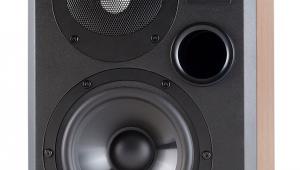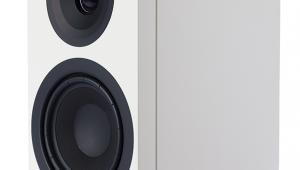Siltech Pantheon (£65,000)
Siltech may be best known as a cable manufacturer but it already has a track record of branching out, in spectacular style, into other product areas. High-end watchers will recall that early in the new millennium Siltech introduced its limited edition 80W Single Ended Mono Triode valve power amplifier and matching preamp, which included novelties such as a specially manufactured output valve. Now from the Dutch company comes a statement loudspeaker design, the Pantheon, with a price tag of £65,000. Once again the engineering is novel and the production run limited – only 39 will ever be made. The difference on this occasion is that, whereas the amplifier led nowhere, the Pantheon is intended to spin off a range of more affordable speakers incorporating some of the same technologies.
DISTINGUISHED PANEL
The extensive computer modelling used in the Pantheon’s development has produced an unconventional design in many respects. Apart from its sheer size (it’s 1.59m tall, 55cm wide and 49cm deep) the first thing about it that catches your eye is the curved electrostatic panel mounted atop the midrange enclosure, which can be tilted forwards to point its axis directly at the listener’s head. This is vital because while the curvature of the panel provides fair horizontal dispersion, its 150mm height makes it about six times more directional than a typical 25mm diameter dome tweeter in the vertical plane. Made specially for Siltech by Indian speaker manufacturer Cadence Audio, this treble panel distinguishes itself from other electrostatics by having an unusually thin (3 micron) PTFE/indium oxide diaphragm which is manufactured in Germany using a hi-tech molecular process that does away with conventional high resistivity coatings. As a result the diaphragm is said to be unusually stable and immune to sparking. Also novel is the panel’s HT supply, which is provided by a long-life multi-cell battery built into the midrange enclosure. This enclosure also contains the step-up transformer that boosts the signal voltage for application to the panel’s fixed plates.
Supporting the treble panel and compliantly isolated from the bass enclosure beneath it, the large midrange enclosure carries a 6in moving-coil driver built to Siltech’s specification by Danish company Audio Technology. Interesting design features here are a decoupled driver magnet structure, to prevent direct coupling of vibration to the front baffle via the driver chassis, and the use of dome-shaped diffuser panels on the internal walls of the enclosure, the purpose of which is to aid suppression of resonances within the enclosed air. Although connected to the bass enclosure by a supplied length of Siltech speaker cable, the midrange enclosure is self-contained in that it incorporates the high-pass section of the bass-mid crossover (crossover frequency 108Hz) as well as the mid-tweeter crossover (at 950Hz), so bi-amping can be used if desired. Bi-wiring can be used too, of course, but Siltech is not a fan.
From the outside the bass enclosure looks conventional save for its gently curved side panels and the fact that it’s on steroids, with a massive 15-inch bass driver, also from Audio Technology. But inside, hidden from view, is a second driver, operating in parallel with the first and communicating with it acoustically via a sealed chamber in an isobaric arrangement. Although the two drivers are the same size, they are of slightly different design to optimise their properties for their different roles. Comsol computer modelling suggested that a low-Q bass alignment would make the Pantheon’s bass performance as room-independent as possible, so the bass response initially rolls off more slowly than in conventional bass reflex designs.
In the sure and certain knowledge that some of you reading this will choose not to dive into the Lab Report, a few words must be said here about the Pantheon’s measured performance. First off, it’s an amplifier ball-breaker. Not because it is of low sensitivity – I measured 88dB, 2dB short of the claimed 90dB – but because of its unfriendly impedance characteristic at low bass and high treble frequencies. Siltech president Edwin van der Kley tells me that he has used the speaker successfully with low powered valve designs but I wouldn’t want to partner it with any amplifier that wasn’t able to sustain its output into very low impedance loads. In the circumstances I was glad to have the services of a Krell FBI integrated amplfier, kindly loaned by Absolute Sounds together with a Krell SACD Standard. Cabling was almost all Siltech, with 2.5m Classic LS-188 speaker cables, a 1m XLR-XLR pair of Compass Lake interconnects between the SACD Standard and FBI, and a 1.5m Ruby Hill mains cable feeding the SACD Standard. That’s more than £10,000’s worth!
WELL CONTROLLED BASS
The second point of note is the Pantheon’s bass response. As described in the interview with Edwin [right], use of an underdamped bass reflex alignment is claimed with a shallow response roll off. But my measurements tell a somewhat different story, of a bass response that has a prominent peak at 40Hz, about 8dB above the 100Hz level, and a shallow dip in the upper bass from about 60 to 150Hz.
Not that the Pantheon displayed a one-note or boomy bass as this might imply. On the contrary, its bass delivery was notably well controlled. It did indeed seem less than usually affected by room modes, as Siltech claims, and it played bass melodies with a clarity and alacrity that eludes most other speakers. But when Edwin briefly heard the speakers in my room, albeit prior to the Krell equipment being put in place, he commented on an apparent lack of output from the bass drivers. The Krell FBI helped a little here, perhaps because the Pantheon is such a difficult load at LF, but my reaction remained the same as Edwin’s throughout my listening. Perhaps because of the shallow upper bass dip apparent in my measurements, the Siltech Pantheons lacked warmth in this region and sounded lean here as a result, particularly on orchestral climaxes which never quite delivered the lift-you-from-your-seat impact that I was expecting.
BOTTOM STRING BALLAST
To get a better idea of what was happening in the extreme bass I dug out a recording of a direct-injected Rickenbacker bass guitar, played by ex-HFN editor John Atkinson, which he sent me a while ago for a Stereophile feature I was preparing at the time. This recording shows no sign of LF roll-off down to 10Hz and includes some powerful notes on the open E string at about 40Hz – just where my measurements showed the Pantheon to have its bass peak. When I played this track I heard nothing untoward – only agile, well extended bass – but there remains a possibility that this is because the Pantheon’s bass peak almost coincides with the first width mode in my room at 41Hz. In-room responses measured at my listening position consistently show a dip at about 45Hz, caused by me sitting on the room centreline and therefore at the node of this first width mode. It is possible, therefore, that the Pantheon’s bass peak was disguised by the room dip. Whatever, my only abiding criticism of the Pantheon’s low-frequency delivery in my listening room was its aforementioned lack of upper bass weight. In other respects it performed admirably, thoroughly belying any expectations of ponderous and overblown LF delivery that its large, reflex-loaded bass cabinet and huge woofer might encourage.
Another thing I admired about the Pantheon was the inertness of its substantial bass and midrange enclosures. This speaker is extremely heavy (bass cabinet 110kg, midrange/treble head unit 35kg) and much of that weight has clearly been put to good use in respect of enclosure stiffness. There was never a hint of the cabinet ‘bloom’ that most box speakers display somewhere in the lower midrange as a result of internal air resonances and/or structural resonances within the enclosure. This means that the Pantheons create a stereo image that really does appear to hang in space independent of the speakers themselves.
That said I was not able to coax from the Pantheons the sheer scale of soundstage that I’m used to hearing. This has at least something to do with the lack of upper bass output I’ve already described, and an overall mid-forward tonal balance that accentuates detail but denudes the sound of some warmth. But I felt there was something more to it than that, particularly in respect of depth reproduction. The Pantheons threw images behind them but both width and depth perspectives were less fully developed than I expected.
MINUTELY DETAILED
The SACD release of the Dave Brubeck Quartet’s ‘Take Five’ [on Time Out, Columbia/Legacy CS 65122] provided a case in point. When a system is really singing this has a big, big drum sound, with Joe Morello’s kit towards the left of the soundstage, and Paul Desmond’s big breathy sax centre-stage. Via the Pantheons the track was minutely detailed but less spacious, less weighty – and hence less able to teleport you back 40-plus years to the recording studio. But ‘Three To Get Ready’, the following track, was as convincing as I’ve ever heard it, with great control and insight – an instance of how the Pantheon could charm and disappoint within the same recording.
These observations were made with my room in its normal condition, with foam absorbent panels dotted around the walls above ear height to control the room’s reverberation time without interfering with the spectral content of first-order early reflections. In a telephone conversation with Edwin he recounted that he’d achieved good results in rooms that are more live than mine, which encouraged me to try removing the two absorbent panels nearest to each Pantheon. The result was better integrated, more convincing imaging. Ironically, while attempting to create a speaker that is room-insensitive at low frequencies Siltech appears to have made one which is unusually room sensitive at high frequencies – almost certainly because of the rear radiation from the treble panel.
I also felt that the Pantheon demonstrated variable communication skills, by which I mean that sometimes it provided great insight into the essence of music making – like it did on ‘Three To Get Ready’ – whereas on other material it would sometimes fail to reach deep enough. An example here was the Seon recording of Mozart violin sonatas with soloists Sigiswald Kuijken and Gustav Leonhardt [SBK 62953]. As I’ve described before, this sometimes edgy original instrument recording is remarkable for the musical energy that flows between the two musicians and through their performance, which elevates it to the unputdownable category when reproduced well. Via the Siltech Pantheon speakers, the result just wasn’t rivetting enough for me.
CLEAN AND ENIGMATIC
As you will have gathered from the above, I found the Pantheon an enigma: great in parts but not sufficiently well-rounded to deliver the life changing experience I was anticipating. It is very clean, very unboxy and highly detailed but has a tonal balance that left me wishing I could turn down the level on the electrostatic panel. It will, of course, sound different in different rooms and with different partnering equipment. I can imagine, for example, that a tonally warmer, softer sounding amplifier might suit it better. But I would need some convincing that it is optimally voiced and that it is possible to combine a monopole, moving-coil midrange section seamlessly to a dipole, electrostatic tweeter, particularly with a crossover frequency around 1kHz. It’s a marriage that others have attempted before and is notoriously difficult to make work.
VERDICT
Unquestionably this is a statement product: one that impresses physically, technically and in aspects of its sound. It has well controlled bass, little if any cabinet coloration and its electrostatic treble panel delivers remarkable detail. But every great speaker must be more than the sum of its parts, and here the Pantheon is less convincing. For this reviewer it doesn’t quite gel into a musically convincing, captivating whole.
Originally published in the February 2008 issue
























































